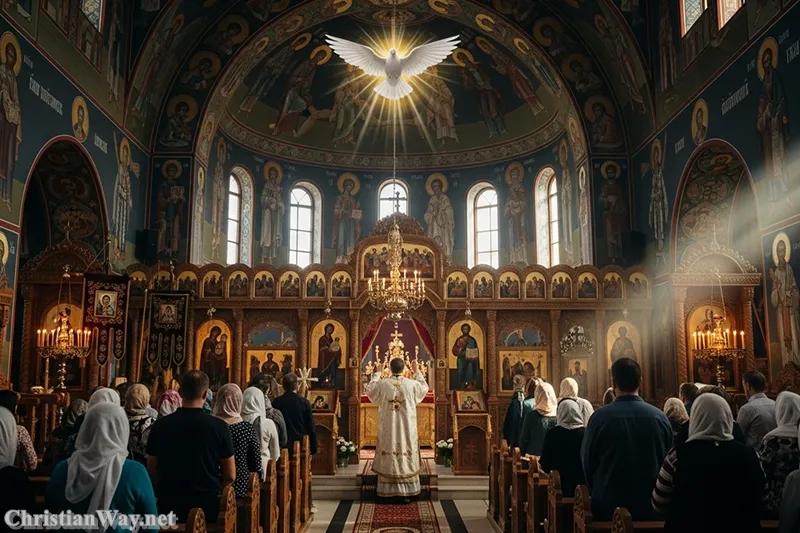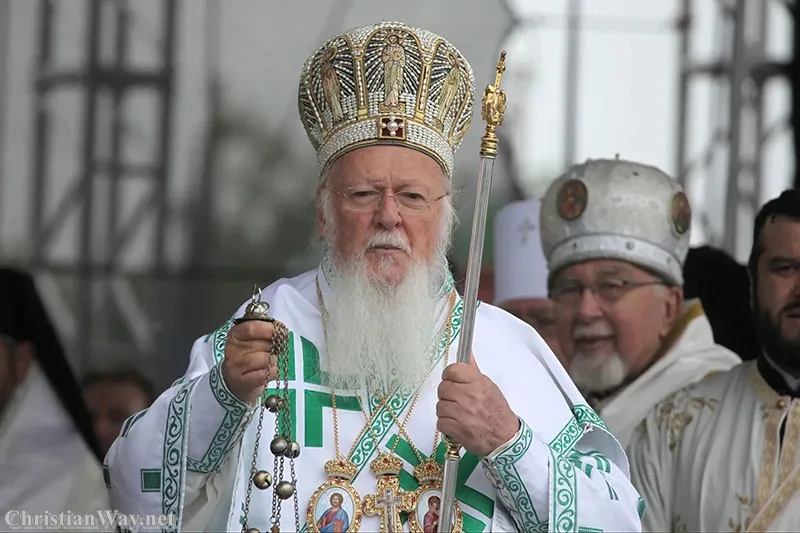Dear friends in Christ,
There is a mystery so profound at the heart of the Christian faith that it cannot be reduced to mere definition — it must be lived, breathed, and entered into with reverence. This mystery is the Church, the Body of Christ. For the Orthodox Christian, the Church is not an institution merely organized by human hands; she is a living organism, divinely fashioned, infused with the life of the Holy Spirit, and united intimately to Christ her Head.
To speak of the Orthodox Church as the Body of Christ is to affirm that salvation is not an individual enterprise, but a communion — a participation in the divine life that flows from Christ Himself. It is to proclaim that God has not only come near to us but has drawn us into His very life, making us “partakers of the divine nature” (2 Peter 1:4).

In this reflection, we will explore the Orthodox vision of the Church — not as a mere symbol of Christ’s presence, but as His real and mystical Body, sanctified through the Holy Spirit, nourished by the Eucharist, and called to manifest His love and truth in the world.
The Church: Christ’s Living Body and Divine-Human Mystery
The Apostle Paul, writing to the Corinthians, speaks with awe: “Now you are the body of Christ and individually members of it” (1 Corinthians 12:27). In those few words lies the entire Orthodox vision of ecclesial life. The Church is not simply a gathering of believers who share common faith and values. She is the continuation of the Incarnation — the very extension of Christ’s life on earth.
For Orthodoxy, this reality is both mystical and tangible. Just as the human body is animated by the soul, so too the Church is animated by the Holy Spirit. Christ is not a distant figure we remember; He is the living Head, inseparably united to His members. This is why Orthodox theology insists that to belong to the Church is to be in communion with Christ Himself — a communion that is real, transformative, and sanctifying.
Saint Ignatius of Antioch, one of the earliest Fathers of the Church, wrote around the year 107 A.D.: “Wherever Jesus Christ is, there is the Catholic (universal) Church.” The Orthodox understanding has never departed from this vision. The Church exists not because of human organization, but because Christ is present, filling her with His life and grace.
The Church as the Continuation of the Incarnation
Christ the Head and the Church His Body
When the Word became flesh, He united divine and human nature in His own person. Through His Body — the Church — He continues to extend that union to all who believe. The Incarnation did not end at Bethlehem or Calvary; it continues through the ages in the mystical life of the Church.
As Saint Paul teaches, “He is the head of the body, the Church” (Colossians 1:18). This image is not metaphorical but ontological — it reveals the very being of the Church. Just as the body cannot live apart from its head, so the Church cannot live apart from Christ. And because the Head and the Body share one life, everything that belongs to Christ is given to His members.
This is why the Orthodox Church speaks not only of believing in Christ but of being in Christ. To be baptized, chrismated, and to receive the Eucharist is to be incorporated into the living reality of His Body. It is a union of life, not merely of thought or intention.
The Holy Spirit: The Soul of the Church
The Holy Spirit, in Orthodox understanding, is the breath and soul of the Church. It is the Spirit who gives her life, guides her into all truth, and makes Christ present in every generation. Without the Spirit, the Church would be a mere institution; with Him, she becomes the living temple of God.
At Pentecost, the Spirit descended upon the apostles, transforming them from frightened disciples into bearers of divine power. This moment is often called the birth of the Church, not because she began to exist then, but because she was revealed in her fullness as the Body of Christ — animated and indwelt by the Holy Spirit.
Orthodox liturgy continually invokes the Holy Spirit: “O Heavenly King, the Comforter, the Spirit of Truth, who art everywhere present and fillest all things, Treasury of good things and Giver of life, come and dwell in us.” This prayer is not only a personal petition; it is the cry of the whole Church, acknowledging that apart from the Spirit, no sacrament, no prayer, no act of love can bear fruit.
It is the Spirit who gathers us into one Body, transcending time and space. In every Divine Liturgy, heaven and earth are united; the saints, angels, and faithful on earth join in one unending hymn of praise. The Church, then, is not simply an earthly community — she is the cosmic Body of Christ, embracing the whole of creation in the Spirit of divine love.
The Eucharist: The Heart of the Church’s Life
If the Church is the Body of Christ, then the Eucharist is her beating heart. It is in the Holy Communion that the Church becomes most truly herself. For in the Eucharist, the faithful receive not mere bread and wine, but the very Body and Blood of Christ — “for the remission of sins and life everlasting.”
As Saint Paul writes, “The cup of blessing which we bless, is it not a participation in the blood of Christ? The bread which we break, is it not a participation in the body of Christ?” (1 Corinthians 10:16). To commune in the Eucharist is to share in the divine life of the Trinity, to become one with Christ and, through Him, one with all who belong to His Body.
This is why the Orthodox Church insists that the Eucharist is not symbolic but real — a true and mysterious participation in the risen Lord. The bread and wine become, by the power of the Holy Spirit, the true Body and Blood of Christ. And through this sacred mystery, we are knit together as one body, transcending divisions of race, language, and nation.
In the Liturgy of St. John Chrysostom, the priest prays, “Unite all of us who partake of this one bread and cup into one another in the communion of the one Holy Spirit.” This prayer expresses the essence of the Church: unity in Christ through the Spirit, made visible in the Eucharistic table.
The Church’s Holiness and Human Weakness
It is true that the Church, though divine in her essence, is composed of human beings — frail, imperfect, and often sinful. Yet her holiness does not come from the moral perfection of her members, but from the indwelling presence of Christ. The Church is holy because Christ is holy, and He has united Himself to her forever.
In Orthodox thought, the Church is often described as a hospital for souls, not a court of the righteous. Within her, sinners are healed by grace, restored through repentance, and transformed by divine mercy. The sacraments — especially Confession and the Eucharist — are the medicine of immortality, by which the wounds of sin are cleansed and the heart renewed.
As Saint John Chrysostom once said, “The Church is not a museum for saints but a hospital for sinners.” The holiness of the Church, therefore, is not a moral achievement but a living reality — the grace of God working in human weakness to make all things new.
The Unity of the Church in Love and Truth
The Body of Christ cannot be divided, for Christ Himself is one. Yet within history, human divisions have appeared — schisms, misunderstandings, and wounds that grieve the heart of Christ. The Orthodox Church holds that unity cannot be achieved by compromise or negotiation, but only by returning to the truth and life of the Holy Spirit.
True unity is Eucharistic — it flows from communion in the same faith, the same sacraments, and the same Spirit. This unity is not uniformity, for the Orthodox Church embraces a diversity of languages, cultures, and traditions. Yet through all this variety, she remains one Body, united by one faith and one baptism.
The ancient Creed of Nicaea expresses this reality: “I believe in one, holy, catholic, and apostolic Church.” These four marks describe not ideals to be reached, but realities already given. The Church is one because she has one Head, Christ. She is holy because the Holy Spirit dwells in her. She is catholic (universal) because she contains the fullness of truth. She is apostolic because she continues the faith and mission of the apostles.
The Church as the Foretaste of the Kingdom
For Orthodox Christians, the Church is not only the Body of Christ on earth; she is also the foretaste of heaven, the first fruits of the Kingdom to come. In her worship, the faithful stand between time and eternity, already participating in the heavenly liturgy. The icons, incense, and chants are not meant to be mere beauty — they are windows into the reality of the Kingdom, where all creation is restored in Christ.
In the Divine Liturgy, we sing, “We have seen the true light, we have received the heavenly Spirit, we have found the true faith.” These words reveal that salvation is not simply a future hope; it is a present reality lived within the Church. The faithful are not waiting to enter heaven — they are already tasting it, for Christ is in their midst.
Saint Maximus the Confessor called the Church “the world transfigured,” a place where heaven and earth meet, where God and humanity are united in love. Through her sacraments, teachings, and prayers, the Church reveals what the world was meant to be — a communion of love in the presence of God.
Living as Members of Christ’s Body
To belong to the Orthodox Church is to be called to a way of life — a life of holiness, repentance, and love. Each believer is a living cell in the Body of Christ, and every act of faith or love strengthens the whole. When one member suffers, the whole Body feels it; when one rejoices, all rejoice together.
The Apostle Paul exhorts us, “Speaking the truth in love, we are to grow up in every way into Him who is the head, into Christ” (Ephesians 4:15). Spiritual growth, therefore, is not an isolated pursuit but a communal journey. The path to salvation is walked together — through prayer, worship, and acts of mercy — within the communion of the Church.
In this light, the Church becomes not only our mother but our home. She nurtures us with grace, teaches us through Scripture and tradition, and leads us ever deeper into the mystery of God’s love.
Reflect and Pray
The Orthodox Church, as the Body of Christ, is not a structure we observe from afar — it is the very life of Christ into which we are drawn. It is where heaven touches earth, where sinners become saints, and where love conquers death.
To belong to this Body is to live in communion — with Christ, with the saints, and with one another. It is to participate in the mystery of divine life, to be renewed continually by the Spirit, and to bear witness to the light of the Kingdom already dawning in our midst.
May we, by God’s grace, live as true members of His Body, loving one another as He has loved us, and offering our lives in thanksgiving for the gift of His Church.
“Now to Him who is able to do far more abundantly than all we ask or think… to Him be glory in the Church and in Christ Jesus to all generations, forever and ever. Amen.” (Ephesians 3:20–21)
— Fr. John Matthew, for Christian Way




